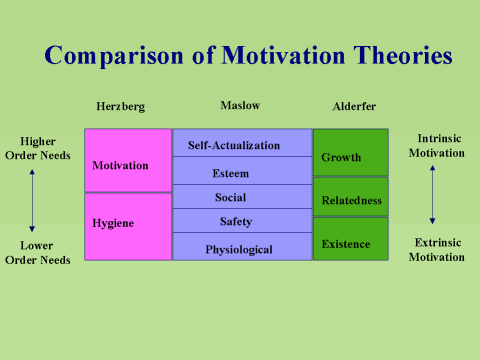What is motivation?
 |
| Is motivating yourself easy? |
Motivation is usually defined as an internal state that arouses, directs
and maintains behaviour. Motivation can be intrinsic or extrinsic. Intrinsic
motivation is the natural tendency to seek out and conquer challenges as we
pursue personal interests and exercise capabilities. When, we are intrinsically
motivated, we do not need incentives or punishments, because the activity
itself is rewarding. For example I may study accounting because I find that mathematics
and financial calculations interest me. I do not need to be convinced by any
other one about the benefits that I could achieve through studying accounting.
However, when we do something to earn a good grade in accounting, or to avoid
punishment, please the teacher or the parent, we experience extrinsic
motivation. We are really not interested in the activity for its own value; we
care only about what it will bring us. The essential difference between the two
types of motivation is the student’ reason for acting, that is, whether the
locus of causality for the action is internal or external.
Motivation is the force that initiates, guides and
maintains goal-oriented behaviors. It is what causes us to take action, whether
to grab a snack to reduce hunger or enroll in college to earn a degree. The
forces that lie beneath motivation can be biological, social, emotional or
cognitive in nature.
Behavioural approaches to motivation.
According to behavioural view an understanding of student motivation
begins with a careful analysis of the incentives and rewards present in the
classroom. A reward is an attractive object or event supplied as a consequence of
a particular behaviour. An incentive is an object or even that encourages or
discourages a behaviour. The possibility of an A grade for me in accounting is
an incentive.
If we consistently reinforce certain behaviours, we may develop
habits or tendencies to act in certain ways. For example if we are repeatedly
rewarded with affection, money, praise for earning letters in football but
receives little recognition for studying the student will probably work longer
and harder on perfecting football skills. Providing stickers, grades and stars
and other reinforcements for learning or
demerits for misbehaviours is an attempt to motivate students by extrinsic
means of incentives, rewards and punishments.
 |
| Does this make any sense to you? |
Cognitive approaches to motivation.
Cognitive theorists believe that behaviour is determined by our
thinking, not simply by whether we have been rewarded or punished. Thus
cognitive theorists emphasize intrinsic motivation. The attribution theory by
Bernard Weiner begins with the assumption that we try to make sense of our own
behaviour and the behaviour of others by searching for explanations and causes.
Attribution theories of motivation describe how the individual explanations,
justifications, and excuses about self or others influence motivation. How this
can be related in classroom is that usually when successful students fail, they
often make internal, controllable attributions. They misunderstand the
directions, lacked the necessary knowledge, or simply did not study hard
enough, for example. As a result, they focus on strategies for succeeding next
time. The greatest motivational problems arise when students attribute failures
to stable, uncontrollable causes. These students respond to failure by focusing
even more on their own inadequacy.
Humanistic Theory of Motivation
Humanistic theories of motivation are based on
the idea that people also have strong cognitive reasons to perform various
actions. This is famously illustrated in Abraham Maslow's hierarchy of needs, which presents different motivations at different levels.
First, people are motivated to fulfill basic biological needs for food and
shelter, as well as those of safety, love and esteem. Once the lower level
needs have been met, the primary motivator becomes the need for self-actualization,
or the desire to fulfill one's individual potential.
So how could we strategize to motivate our students?
Until four basic conditions are met, not motivational strategies
will succeed. Firstly, the classroom must be relatively organized and free from
constant interruptions and disruptions. The teacher must be patient, supportive
and who never embarrasses students for mistakes. Everyone in the classroom
should see mistakes as opportunities for learning. The work assigned must be
challenging but reasonable. If work is too easy or too difficult, students will
have little motivation to learn.
How to build confidence and positive expectations.
We should begin at the student’s level and move in small steps. The
pace should be brisk, but not so fast that students have to move to the next
step before they understood the previous one. Make sure that learning goals are
clear and specific and possible to reach in the near future. If possible we can
give students a range of goals at different levels of difficulty and let them
choose. Stress self-comparison, not comparison with others. Point out how much
students have improved. Communicate with students that academic ability is
improvable and specific to the task at hand. Do not undermine your efforts to
stress improvement by displaying only the 100% papers. Model good problem
solving by trying several approaches to get a solution.
To establish attainment value, we must connect the learning task
with the needs of the students. We can tie class activities to student interests
like sports, music, current events, pets and mobile phones. Arouse curiosity by
puzzling discrepancies between students’ thinking and the facts. Make the use
of novelty and familiarity by varying the goal structures of tasks
(cooperative, competitive, individualistic) can help. Sometime it is difficult
to encourage intrinsic motivation and so teachers must rely on utility or
instrumental value of tasks. In some situations teachers can provide incentives
and rewards for learning.
No comments:
Post a Comment